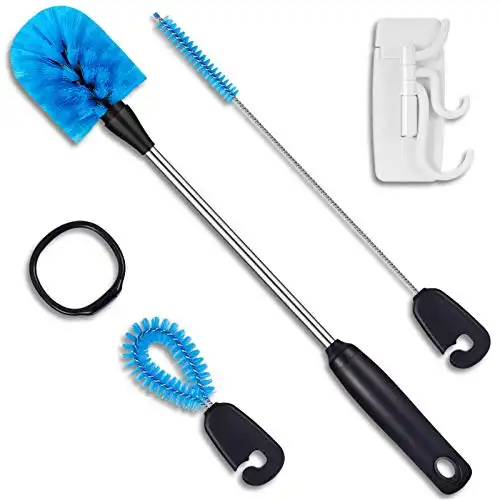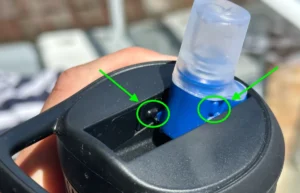We’ve all let our water bottles get a bit more nasty than we should before.
I know the last thing I want to do when I get back from a long, grueling backpacking trip (or even a hard day at work) is to stop and wash my Nalgene.
But unfortunately, this sometimes leads to stubborn funky smells or, in worst cases, mold growing in the bottle.
So what exactly should you do when your Nalgene Bottle starts to stink or grow mold? Is it just time for a new bottle? No! Don't throw your bottle out, it's easy to save it and get rid of the mold.
To clean mold from a Nalgene Bottle, rinse the bottle, soak it with diluted vinegar overnight (using a one-to-one ratio with hot water), scrub with baking soda, rest for 15 minutes, wash with dish detergent, and let the bottle air dry.
To get rid of bad smells in a Nalgene Bottle, start with a thorough wash, soak it with vinegar or diluted bleach, use water bottle cleaning tablets, or shake uncooked rice and detergent inside. If the bad smell is earthy and mildewy, it means that your bottle has mold and you should follow the steps above instead.
Most moldy and stinky Nalgene Bottles are easily salvageable, as long as you know the proper methods to clean them.
But whatever you do, don’t ignore the issue. Continuing to drink from a moldy or smelly Nalgene Bottle could make you sick.
Can Nalgene Bottles Grow Mold?

If you don’t wash your Nalgene Bottle properly or often enough, it may begin to grow mold.
Mold thrives in damp, dark places, making the underside of your bottle’s lid the perfect spot to grow.
Fortunately, Nalgene bottles are less prone to mold than many other water bottles because they’re transparent (so the interior isn’t as dark) and don’t have a gasket in the lid (one of the most common areas that mold grows in other bottles).
Regardless, it’s important to wash your Nalgene Bottle thoroughly at least once every few days to prevent mold from growing.
Why Does My Nalgene Bottle Have A Bad Smell?
Just because you don’t see any mold in your bottle, doesn’t mean it isn’t there.
One of the first signs of mold, well before you can actually see it with the naked eye, is a damp earthy or mildewy smell.
It’s a good sign to immediately stop drinking from your bottle until you can give it a thorough cleaning.
If you drink coffee, tea, smoothies, or anything else that isn’t water from your Nalgene, daily washing is even more important to prevent odors from developing — and is particularly true of anything that contains milk or milk protein.
What Happens If You Drink From A Moldy Nalgene Bottle?
While most types of mold are relatively harmless and easily destroyed by your stomach acid, there are some that can make you pretty sick.
Black mold in particular is a type of harmful mold commonly found in water bottles.
Although it’s unlikely to cause any serious, lasting harm, drinking from a moldy bottle can cause nausea, cramping, diarrhea, respiratory problems, and infections.
How To Get Rid Of Mold In A Nalgene Bottle
If you spot mold growing in your Nalgene or notice a mildewy smell, you need to thoroughly clean your bottle before drinking from it again.
Step 1: Rinse Well And Soak If Needed
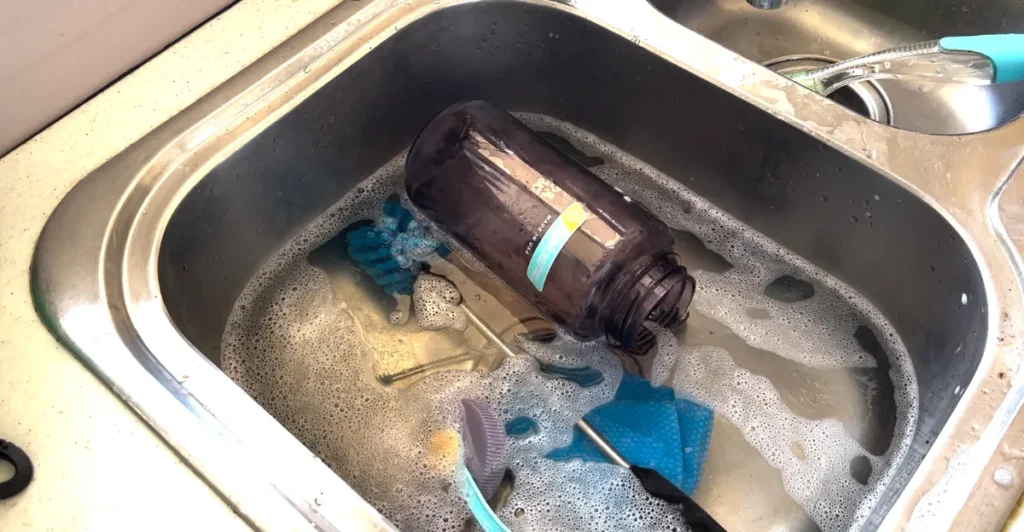
Pour out the contents of your bottle then rinse it out under warm running water to remove any leftover drink.
Step 2: Add Vinegar And Soak
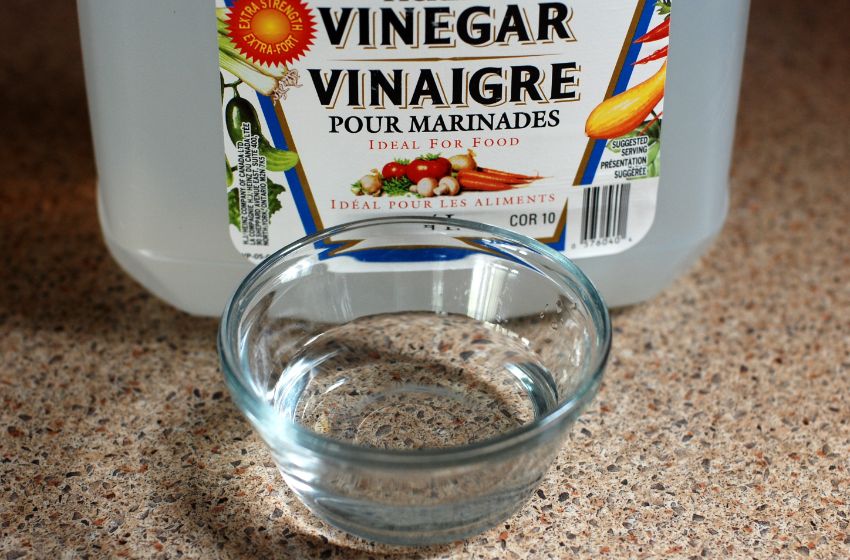
Studies have shown that vinegar is an effective anti-fungal, killing up to 82% of mold spores.
Fill your bottle with equal parts water and distilled white vinegar, shake, and let soak for at least 30 minutes or as long as overnight.
If you're really really worried then you can also use undiluted vinegar, but I wouldn't do this too often as it can be more corrosive to the plastic.
If you suspect that there is mold in the lid then fill a bucket up with equal parts vinegar and water and submerge your bottle and lid in the solution and leave overnight.
You may need to fill up your bottle with rocks, heavy cutlery or something else to keep it under the vinegar solution.
Step 3: Scrub With Baking Soda
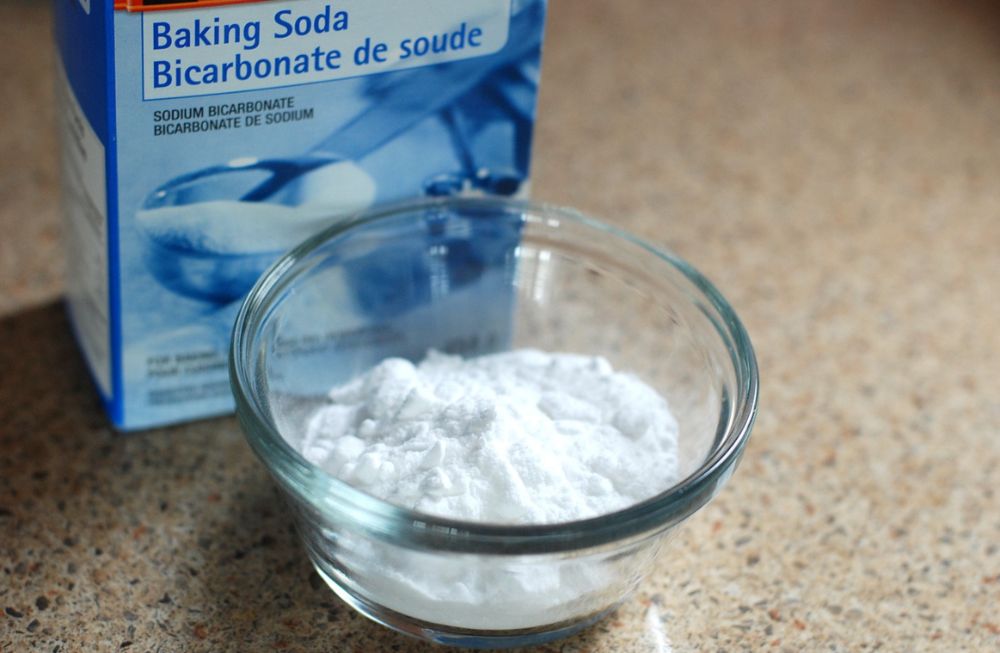
Make a paste out of baking soda and water.
Scrub your bottle with the baking soda paste using a bottle brush, making sure to scrub every surface of the bottle’s interior, lid, and threads.
You may notice some fizzing from the baking soda and vinegar reacting, which is perfectly normal and will actually help the cleaning process.
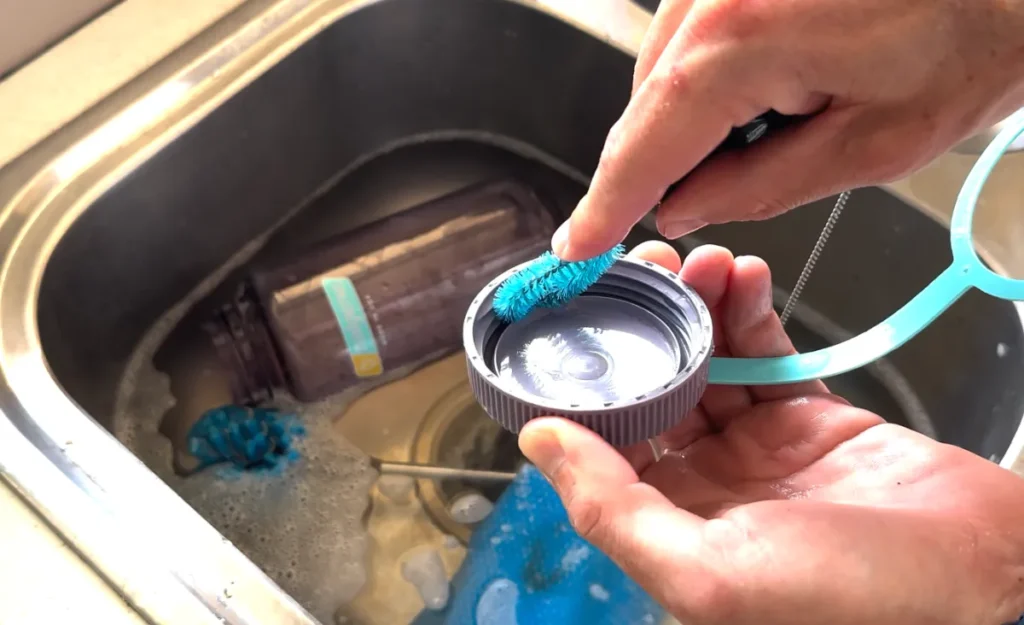
A toothbrush or small bottle brush can help scrub the cracks and crevices in the underside of the cap.
Make sure to really get into and scrub all the threads of the lid itself as this is one of the most common areas for mold.
I use and recommend this 3-in-1 bottle brush set (from Amazon)as it comes with a bottle brush that works great for cleaning the Nalgene bottle and also the small brush is perfect for cleaning the lid of the bottle.
Three tools in one. Includes a long bottle brush, straw brush and detail cleaner (great for cleaning inside lid gaskets). Comes with organizer ring and storage hook,
Step 4: Let The Bottle Sit For 15 Minutes Before Rinsing
Let the baking soda sit for about 15 minutes, then thoroughly rinse out the bottle with hot running water.
You want to make sure you rinse the bottle really well to get rid of all the vinegar.
Step 5: Wash With Dish Soap
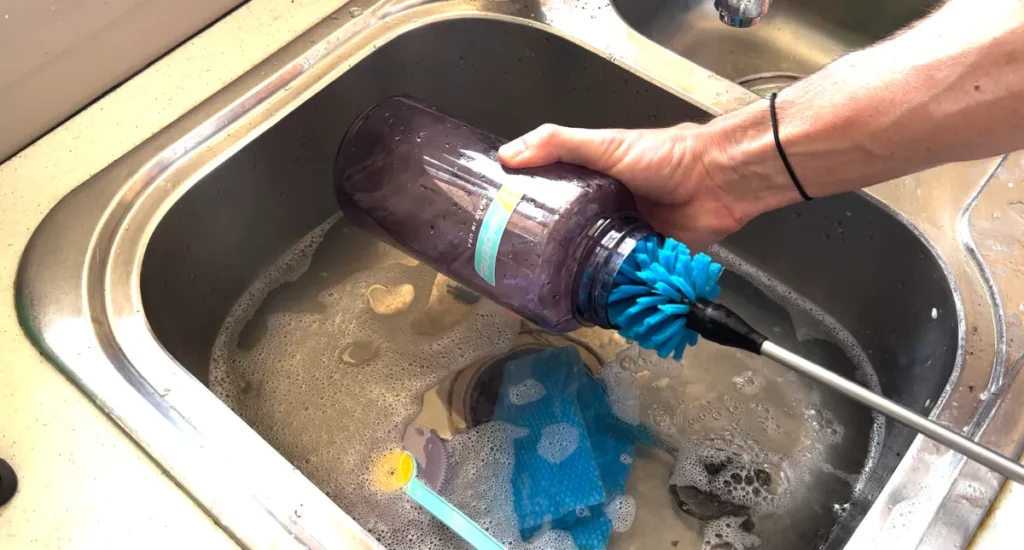
Wash the bottle once again using dish soap and a bottle brush. The dish soap will help to remove the vinegar smell and taste from your bottle so it doesn't feel like you're drinking vinegar.
Rinse well under hot running water to remove all detergent, vinegar, and baking soda.
Step 6: Air Dry
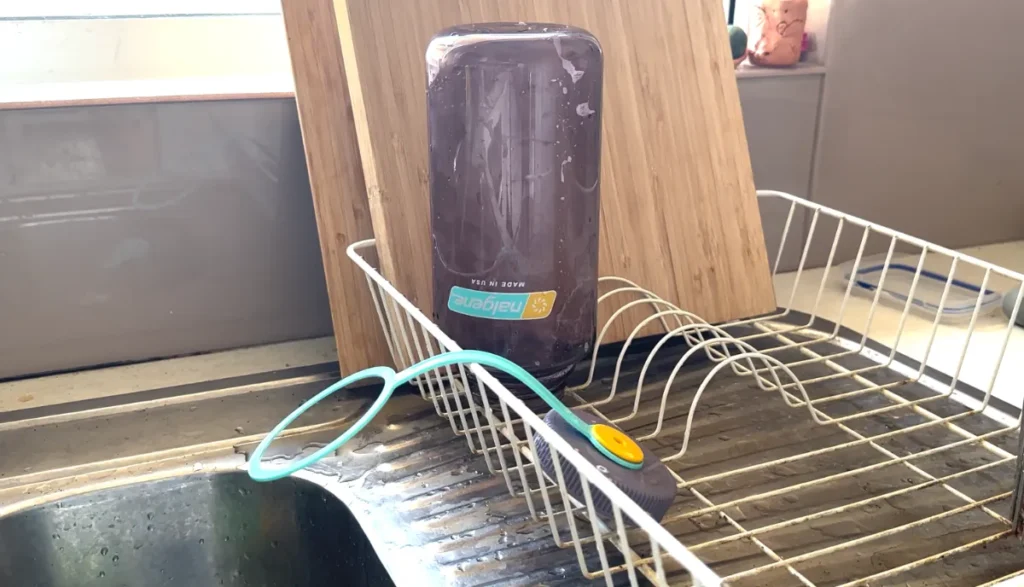
Air dry the bottle upside down on a drying rack, slightly angled to allow some air flow and so it completely dries.
I find it extremely useful to store the bottle with the cap off until you’re ready to use it again.
This both prevents mold from growing as no moisture is trapped, but it also helps the vinegar smell to escape and your bottle to return to normal.
If you find your bottle seems to taste like vinegar after this process then running it through the washing machine can help (yes, Nalgene bottles are dishwasher safe) or fill the bottle up with hot or boiling water (yes, you can put boiling water in a Nalgene) and leave to soak for a day. Then discard this water.
Either of these methods should remove the vinegar smell/taste.
How To Get Rid Of Bad Smells In A Nalgene Bottle
If your bottle has a foul odor that isn’t related to mold, there are a few methods you can use to get rid of the stink.
If the bad smell is earthy and mildewy, the problem is most likely mold. Use the method above instead.
Give It A Good Wash
Most bad smells can be solved by just giving your bottle a good wash.
Simply fill your sink with warm, soapy water and give the bottle a scrub with a bottle brush. Rinse well and let the bottle air dry.
Run It Through The Dishwasher
Dishwasher have extended cleaning cycles that means your Nalgene is going to get a good solid wash as well as be exposed to steam and heat that can kill and get rid of bad smells.
Nalgene bottles and lids are dishwasher safe but I do advise you placing them on the top rack where possible as this exposes them to less heat. However, bottom rack is still fine as Nalgene bottles can handle higher temperatures than a dishwasher delivers without warping or melting.
This method works best for wide mouth Nalgene bottles but it doesn't work as well for narrow mouth ones. Click here to learn how to clean a narrow mouth Nalgene bottle.
Soak With Vinegar Or Diluted Bleach
If a single wash doesn’t remove the odor, soaking your bottle with vinegar or diluted bleach may.
- Rinse out your bottle with hot running water.
- Fill it with hot water and distilled white vinegar at a one-to-one ratio.
- Shake well.
- Let the bottle soak for an hour or two or up to overnight.
- Flip the bottle and let it soak upside down for at least an hour so the underside of the cap gets cleaned as well.
- Rinse, hand wash, and air dry as normal.
If the bottle was particularly nasty, use hot water with a few drops of bleach instead of vinegar.
Just be careful not to overdo it. Using too much bleach or using bleach too often may damage your bottle.
Click here for my details guide on how to properly clean a Nalgene bottle
Use Water Bottle Cleaning Tablets
An even easier (which is a nice way to say lazier) way is to use water bottle cleaning tablets, like these from Bottle Bright.
All you need to do is fill the bottle with hot water, drop in a tablet, and let it work its magic.
After 15 or 20 minutes, your bottle will be sparkling clean and even the most stubborn smells should be removed.
All natural, safe, free of odor and harmful ingredients. This is perfect for cleaning tumblers and water bottles giving them a fresh look and smell. No scrubbing required. Made in the USA
Dry Rice + Detergent Or Vinegar or Salt + Ice

If the odor is caused by built-up residue on the interior of your bottle, this method may do the trick.
- Drop a handful of uncooked rice, ⅓ bottle of water, and some vinegar or dish soap in your Nalgene.
- Replace the lid.
- Shake vigorously for 2 or 3 minutes.
- Wash, rinse, and air dry the bottle.
The uncooked rice acts as an abrasive on the inside of the bottle and often removes residue from your bottle better than a bottle brush could.
This is also a great way to fix a cloudy Nalgene bottle and make it look (nearly) brand new again.
An alternative method to this is to use salt and ice instead of dry rice and it will have a similar effect.
What NOT To Do With A Moldy Or Smelly Nalgene Bottle
Although Nalgene Bottles are pretty durable, they can still be damaged if you use the wrong method to remove mold or odor.
Use The Dishwasher Sparingly
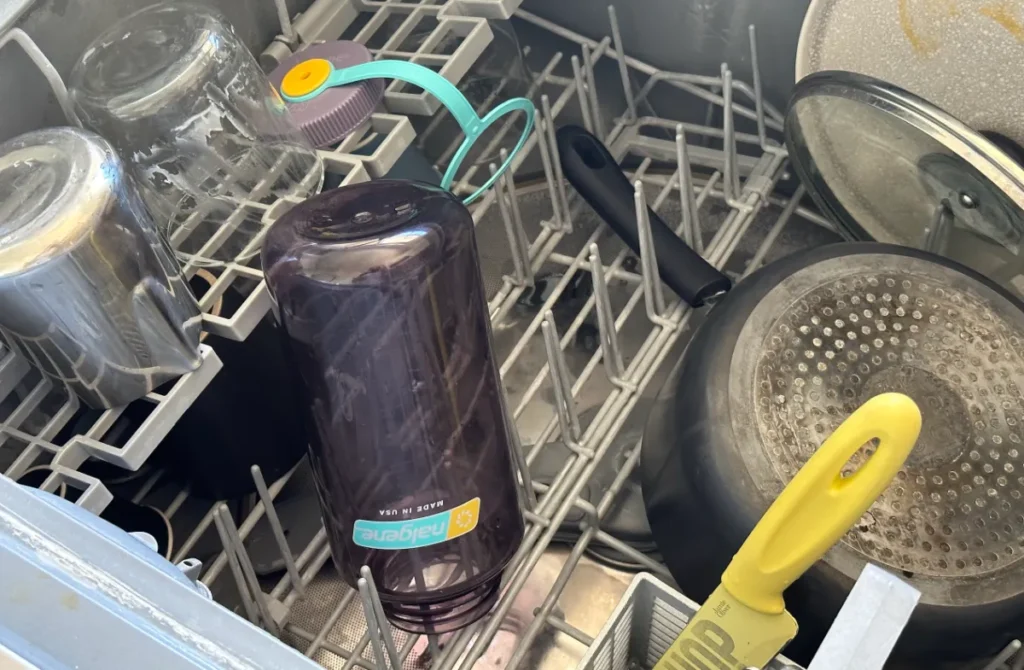
Although Nalgene Bottles are dishwasher safe, there have been studies that show that machine washing reusable plastic water bottles could make them leach more chemicals into your water.
I try to hand wash my Nalgene Bottles whenever possible, but still end up using the dishwasher on occasion.
After all, Nalgene Bottles can handle some pretty high temperatures so how bad could it be?
Don’t Overdo The Bleach
Bleach is corrosive to plastic and will slowly wear down your Nalgene.
If you do deep clean your bottle with bleach, make sure it’s heavily diluted. A couple drops is plenty for a standard 32 oz bottle.
Alcohol And Ammonia-Based Cleaners
Cleaners that contain alcohol or ammonia can cause Nalgene Bottles to yellow, haze, or craze (making the plastic brittle).
Check the label of whatever cleaner you decide to use to make sure it's alcohol-free and ammonia-free.
Avoid Abrasive Bottle Brushes, Sponges, And Steel Wool

Steel wool and overly abrasive sponges and bottle brushes will leave small surface scratches on the interior of your bottle, which can make more chemicals leach into your water.
They can also cause your Nalgene bottle to become cloudy from micro-scratches in the plastic and these can't be fixed or washed away.
How To Prevent Your Nalgene From Getting Moldy Or Smelly
Ultimately, your best bet is to just prevent your Nalgene from getting smelly or moldy in the first place.
Learn to clean your Nalgene properly and make sure you wash it often enough.
If you’re only drinking water from your Nalgene, you can probably get away with washing it once every few days. Still dump it out and rinse daily.
If you drink anything other than water from your Nalgene, it should be washed daily.

